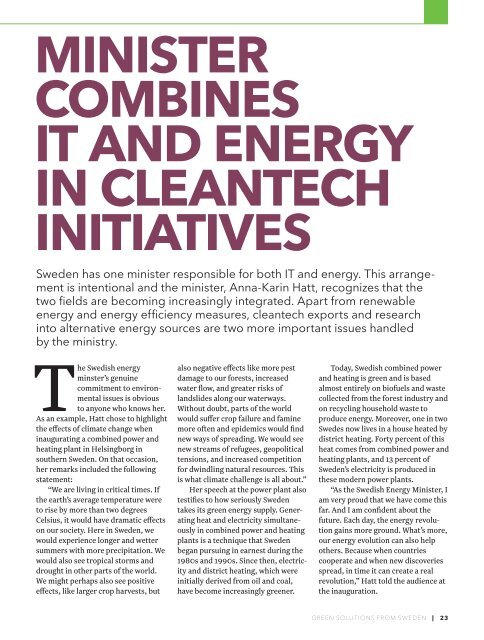GREEN SOLUTIONS
GREEN SOLUTIONS
GREEN SOLUTIONS
Create successful ePaper yourself
Turn your PDF publications into a flip-book with our unique Google optimized e-Paper software.
Minister<br />
CoMbines<br />
it and energy<br />
in CleanteCh<br />
initiatives<br />
Sweden has one minister responsible for both IT and energy. This arrangement<br />
is intentional and the minister, Anna-Karin Hatt, recognizes that the<br />
two fields are becoming increasingly integrated. Apart from renewable<br />
energy and energy efficiency measures, cleantech exports and research<br />
into alternative energy sources are two more important issues handled<br />
by the ministry.<br />
The Swedish energy<br />
minster’s genuine<br />
commitment to environmental<br />
issues is obvious<br />
to anyone who knows her.<br />
As an example, Hatt chose to highlight<br />
the effects of climate change when<br />
inaugurating a combined power and<br />
heating plant in Helsingborg in<br />
southern Sweden. On that occasion,<br />
her remarks included the following<br />
statement:<br />
“We are living in critical times. If<br />
the earth’s average temperature were<br />
to rise by more than two degrees<br />
Celsius, it would have dramatic effects<br />
on our society. Here in Sweden, we<br />
would experience longer and wetter<br />
summers with more precipitation. We<br />
would also see tropical storms and<br />
drought in other parts of the world.<br />
We might perhaps also see positive<br />
effects, like larger crop harvests, but<br />
also negative effects like more pest<br />
damage to our forests, increased<br />
water flow, and greater risks of<br />
landslides along our waterways.<br />
Without doubt, parts of the world<br />
would suffer crop failure and famine<br />
more often and epidemics would find<br />
new ways of spreading. We would see<br />
new streams of refugees, geopolitical<br />
tensions, and increased competition<br />
for dwindling natural resources. This<br />
is what climate challenge is all about.”<br />
Her speech at the power plant also<br />
testifies to how seriously Sweden<br />
takes its green energy supply. Generating<br />
heat and electricity simultaneously<br />
in combined power and heating<br />
plants is a technique that Sweden<br />
began pursuing in earnest during the<br />
1980s and 1990s. Since then, electricity<br />
and district heating, which were<br />
initially derived from oil and coal,<br />
have become increasingly greener.<br />
Today, Swedish combined power<br />
and heating is green and is based<br />
almost entirely on biofuels and waste<br />
collected from the forest industry and<br />
on recycling household waste to<br />
produce energy. Moreover, one in two<br />
Swedes now lives in a house heated by<br />
district heating. Forty percent of this<br />
heat comes from combined power and<br />
heating plants, and 13 percent of<br />
Sweden’s electricity is produced in<br />
these modern power plants.<br />
“As the Swedish Energy Minister, I<br />
am very proud that we have come this<br />
far. And I am confident about the<br />
future. Each day, the energy revolution<br />
gains more ground. What’s more,<br />
our energy evolution can also help<br />
others. Because when countries<br />
cooperate and when new discoveries<br />
spread, in time it can create a real<br />
revolution,” Hatt told the audience at<br />
the inauguration.<br />
<strong>GREEN</strong> <strong>SOLUTIONS</strong> FROM SWEDEN | 23


